A History of Candy Corn
Or Why This Divisive Halloween Treat Deserves a Second Chance (and Maybe a Spot on Your Peanut Butter Sandwich)
Before the internet, I wasn’t aware that people had a problem with things like pineapple on pizza or candy corn, but apparently, according to thousands of articles, these are very divisive foods. Personally, I don’t have an issue with either of these foods. In fact, when it comes to candy corn, I am a cheerleader. Every year, when the weather cools and Halloween in nearing, I make sure to pick up a bag or two and by the time November rolls around, I have usually eaten all of it. I have eaten this foodstuff all my life, but I until recently I didn’t know much about its history.
Candy corn was created in the 1880s by George Renninger, an employee of the Wunderle Candy Company in Philadelphia. Originally called "Chicken Feed," the candy was designed to resemble corn kernels and targeted toward farmers, which were a significant population in America at the time. The treat quickly became popular due to its unique design, colorful tri-colored appearance, and sweet taste. In 1900, the Goelitz Confectionery Company (now known as Jelly Belly) began mass-producing candy corn, helping solidify its status as a seasonal treat associated with Halloween.
Candy corn, which are also called mellowcremes, are made from sugar, corn syrup, and other ingredients (sometimes honey). The candy was initially produced manually in large kettles. Candymakers would painstakingly pour the different colored layers one at a time into molds shaped like corn kernels. It was a crazy labor-intensive effort, but demand kept growing.
By the mid-20th century, advancements in technology allowed for mass production of candy corn. This made it cheaper and quicker to make, but larger production also meant it was more widely available. Candy corn wasn’t just for farmers anymore. And it really found its niche in the 1950s when it started to get passed out to Trick or Treaters during Halloween. While the process of making it has evolved, the basic ingredients and tri-color design have remained consistent. Today, candy corn is a staple of Halloween in the United States, with millions of pounds produced each year.
Here is Food Network’s Unwrapped with a brief history and “How It’s Made” about candy corn.
Along with traditional candy corn, I also or sometimes even prefer the "Mellowcreme Pumpkins." These are made from the same ingredients as candy corn but shaped like small pumpkins with a green stem. Brach's is a major producer of these pumpkins, and they are commonly included in Halloween-themed candy mixes alongside candy corn. The pumpkins have a similar taste to candy corn, but are larger and have a slightly different texture due to their size and shape. If you have never tried them, I highly suggest you add them to your mix this year.
In addition to Jelly Belly, several other companies now produce candy corn, including Brach's, one of the largest manufacturers, as well as smaller brands like Zachary Confections. I always bought Brach’s. It is the version I grew up with, but over the last few years I have come around to Jelly Belly. So now I buy a bag of each. Typically finishing the smaller Jelly Belly bag first, then the Brach’s lingers through November.
While I prefer the big name brands, keep your eyes open this time of year for smaller brands. Candy corn is an affordable treat, so you can often find it in the discount candy section. You won’t get a superior tasting product, but they will frequently have fascinating or even retro-looking packaging. A few years ago, I picked up this package from Mayfair. Just look at this design.
I mentioned that I regularly have extra candy corn after the season has ended, and I got a great suggestion from Roger Barr over at i-Mockery, add it to a peanut butter sandwich. I was skeptical at first. Peanut butter is a strong flavor, but the candy corn does pop through and add some sweetness. My suggestion is to go with an open-faced sandwich to cut down on the candy to bread ratio.
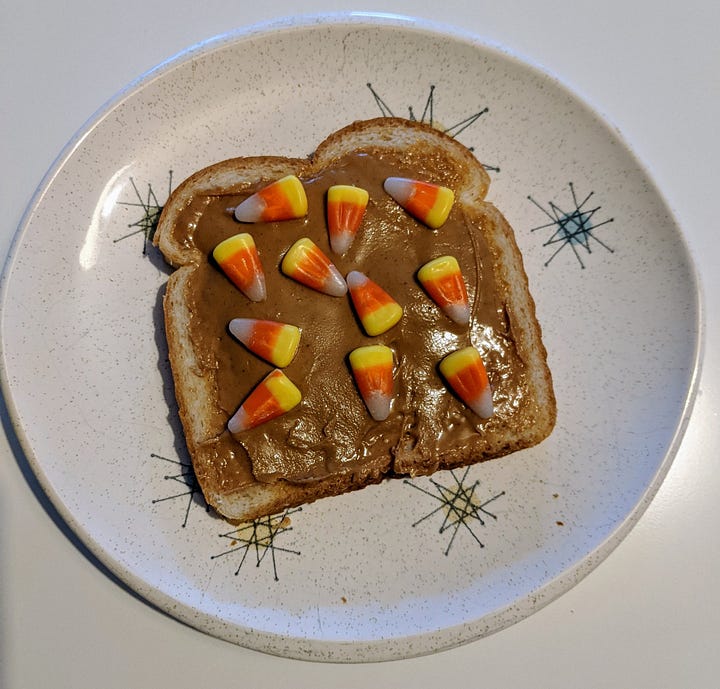
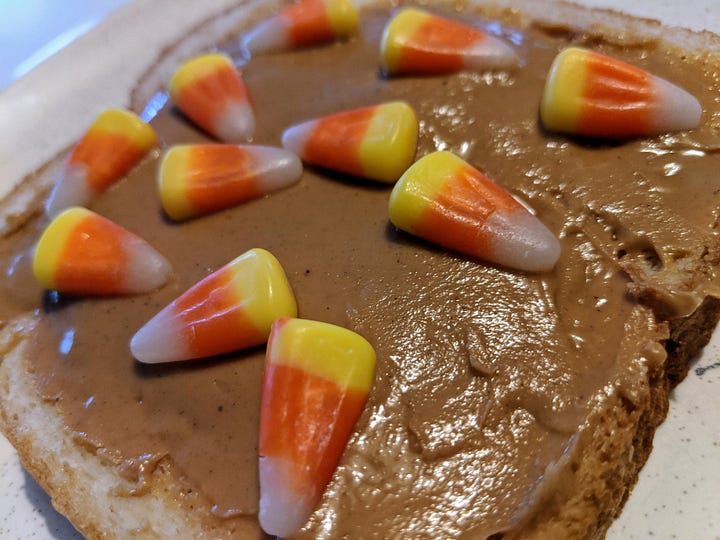
While the traditional tri-color version is the most popular, candy corn has evolved to include a variety of flavors and colors. Some common variants include "Indian Corn," which features brown, orange, and white colors and a chocolate-flavored base, and "Reindeer Corn," which comes in red, green, and white for the Christmas season. There are also modern takes on the classic, such as caramel apple, s'mores, and of course pumpkin spice-flavored candy corn. The combinations and theming possibilities are nearly endless.
Whether you're a fan of candy corn or one of its many detractors, there’s no denying its place in the world of seasonal treats. For me, it’s more than just a sugary snack, it’s a reminder of fall, Halloween, and childhood traditions. Every year, the sight of those sugary little yellow, orange, and white kernels signals the start of the holiday season, and I can’t imagine October without them. So, whether you're indulging in classic candy corn, mellowcreme pumpkins, or one of the newer flavors, I hope you'll find a way to enjoy this quirky, colorful candy. After all, traditions are meant to be sweet.
And who knows? If you’ve never been a candy corn fan, maybe this is the year to give it another shot. Try it in a different mix or a new flavor. You might just surprise yourself, and if nothing else, you’ll have a story to tell about this divisive little candy that somehow continues to spark debate year after year.



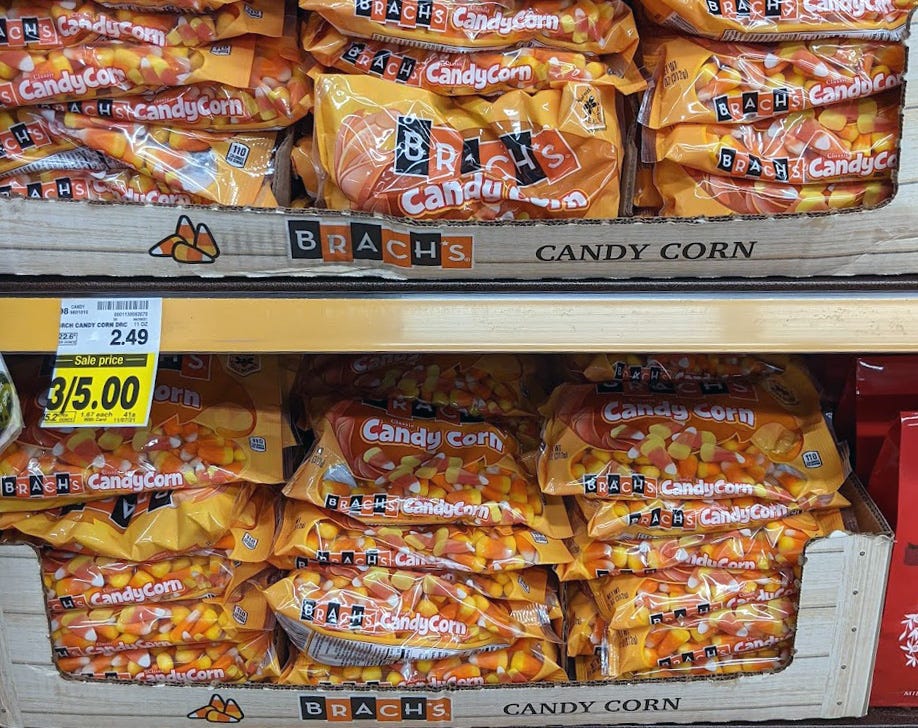
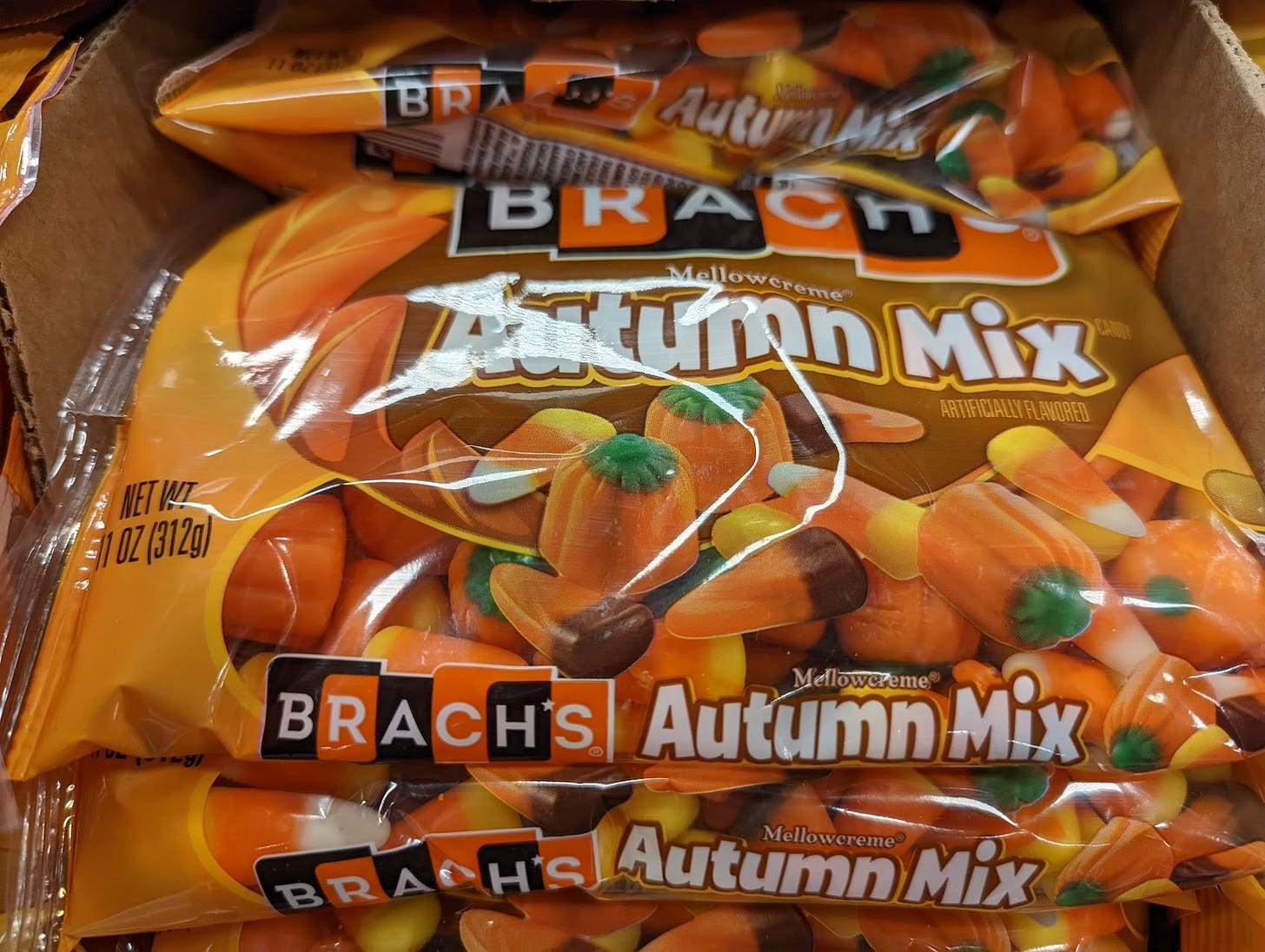
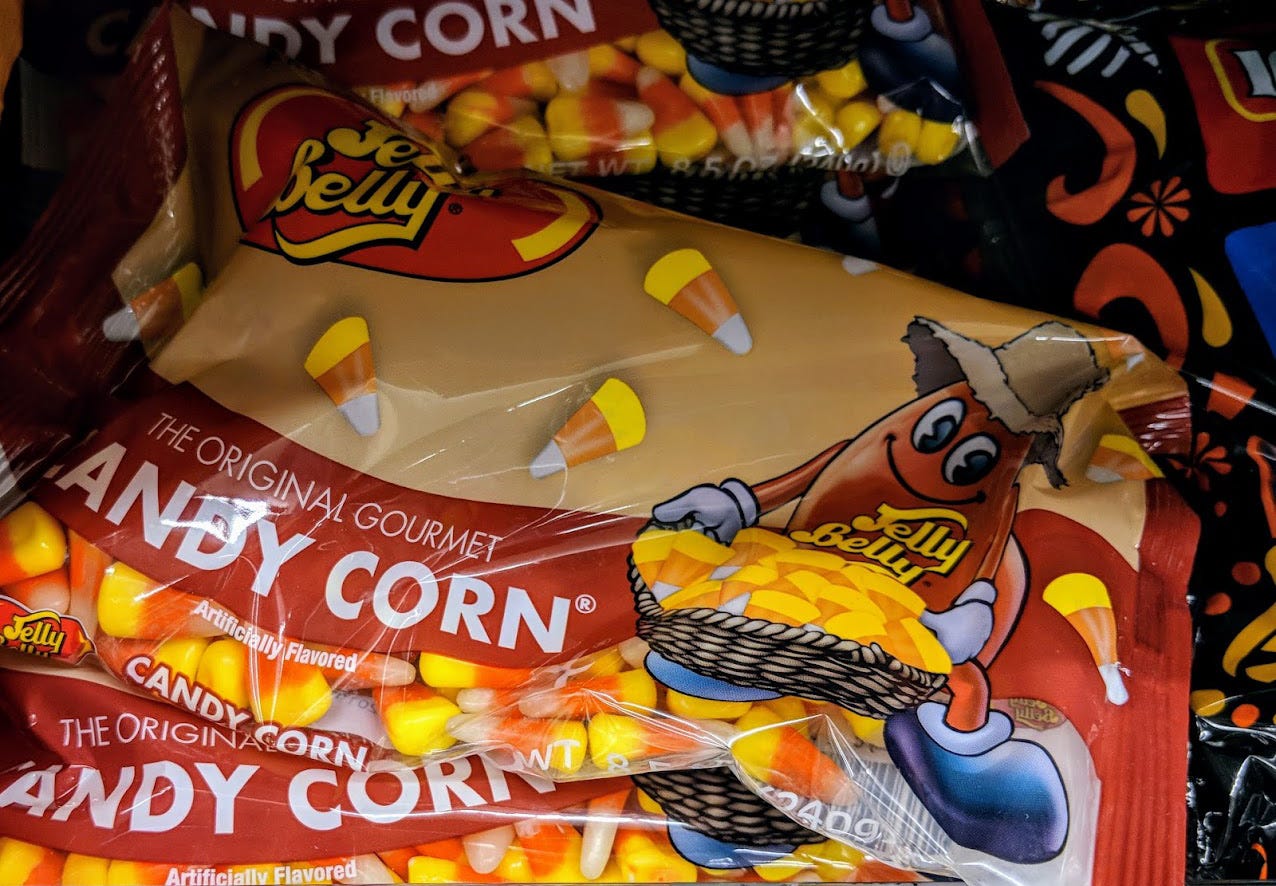
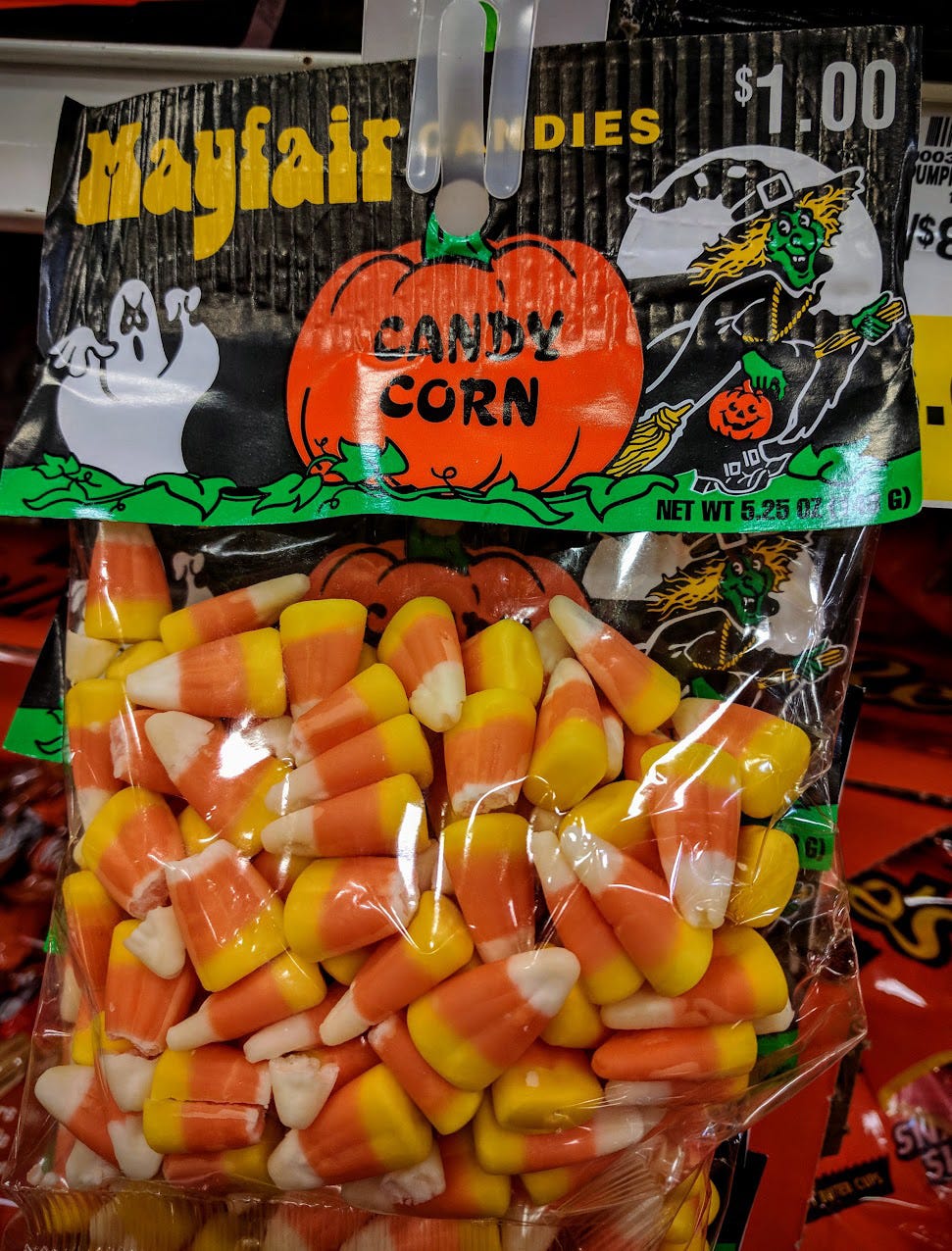
I'm with you, candy corn is awesome and I don't get the hate for it. I especially like it mixed with roasted, salted peanuts. Addictive!
I wish I could quit you, candy corn.